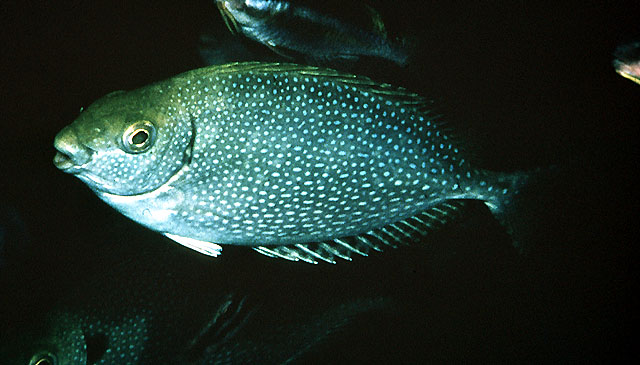| Siganidae (Rabbitfishes) |
| 40 cm TL (male/unsexed); max.weight: 1,160.0 g |
|
reef-associated; brackish; marine; depth range 1 - 50 m, oceanodromous |
| Western Pacific: southern Korea, southern Japan, Ogasawara Islands, Taiwan, southern China, Malaysia, Singapore, Thailand, Andaman Islands, Indonesia, Philippines, Yap, Palau, Pohnpei (Caroline Islands), Solomon Islands, Papua New Guinea, Vanuatu, New Caledonia, and Australia. Often misidentified as Siganus canaliculatus (Ref. 2334). |
|
Dorsal spines (total): 13-13; Dorsal soft rays (total): 10-10; Anal spines: 7-7; Anal soft rays: 9-9; Vertebrae: 13-13. Body olive green or brown above, silvery below; fish frequently with a dark patch below origin of lateral line. Adults become mottled when frightened. Slender, pungent, venomous spines. Preopercular angle 89°-95°. Lower half to 2/3 of cheeks commonly covered with weak, scattered scales. Midline of thorax between pelvic ridges. Differs from S. argenteus in details of coloration and less deeply forked tail (Ref. 37816). |
| Inhabits algal and seagrass flats and shallow lagoon and coastal reefs (Ref. 9710, 11230). Forms schools. Mainly diurnal. Juveniles feed on filamentous algae, adults feed on leafy algae and seagrasses (Ref. 9710). Commercially cultured in Japan. Commonly found in large estuaries (Ref. 9002). Anterolateral glandular groove with venom gland (Ref. 57406). |
|
Least Concern (LC); Date assessed: 10 March 2015 Ref. (130435)
|
| venomous |
Source and more info: www.fishbase.org. For personal, classroom, and other internal use only. Not for publication.
